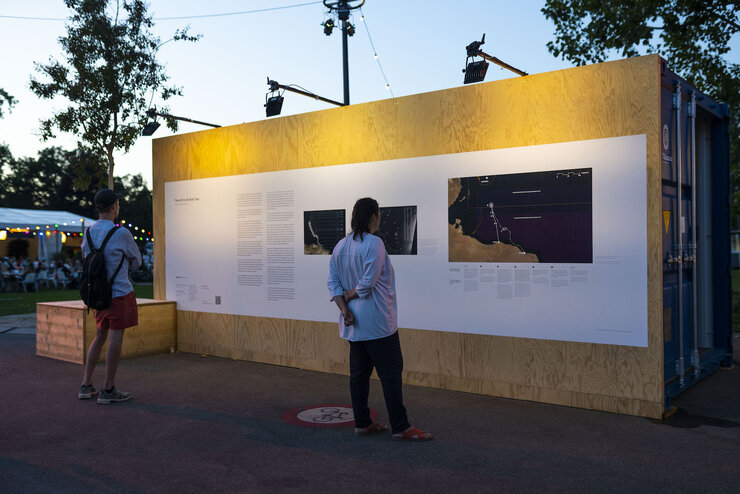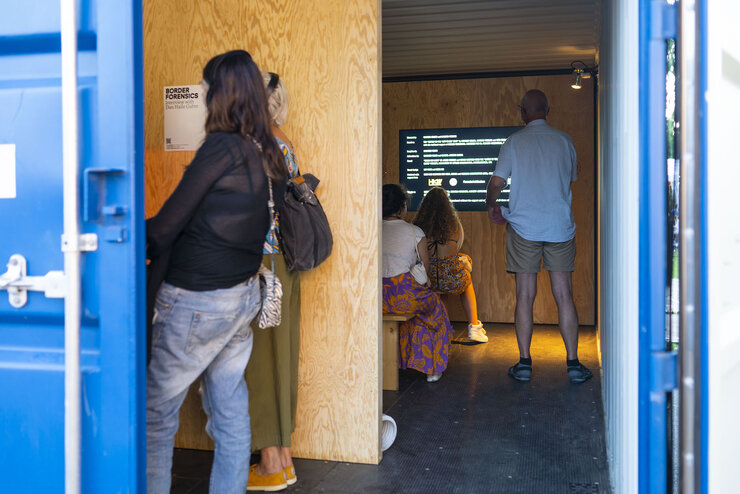The disobedient gaze
Interview with Charles Heller from Border Forensics
The research agency Border Forensics, which emerged from the research project Forensic Oceanography, uses the means of science, research, architecture, art and – as the name suggests – forensics, to deal with serious violations of human rights; specifically with violence at borders. Their works, which resist any categorisation, are used both as evidence in trials and presented in the context of art. At the Theater Spektakel, they are presenting an installation with two video investigations. In conversation, Charles Heller, head of the Border Forensics Team, explains the complexity of the investigative work and how it can gain visibility.

Marta Piras: You proposed starting with the basics. So, what is a border?
Charles Heller: In the thinking of a philosopher called Etienne Balibar – who's been very influential for me and for us – who's been very influential for me and for us –borders are understood as more than the territorial limits located at the edges of states. Borders institute a regime of inclusion and exclusion of certain subjects, based on citizenship, class, race, sometimes gender.
So, borders don't operate in the same way for everybody, right? A person from the global north who travels as a tourist with relative freedom has a completely different experience of borders than an illegalised migrant from the global south. Borders tend to disappear for the former, and proliferate along the entire trajectories of the later. Borders, in fact are a political technology that serves to police the social boundaries of class, of race on a global scale. Borders come into being, they materialise wherever that relation of inclusion and exclusion is policed, and this can be far from the border line.
Can the understanding of «violence» be expanded in a similar way? Why is it important to expand these terms?
In the strictest understanding of the border as a line, and of violence as direct violence, all you could perceive as border violence would be, let’s say, a border guard beating or shooting a person as they attempt to cross the territorial line of a border. But such a limited understanding occludes many other ways in which the existence and management of borders generates harm.
Take «Liquid Traces: The Left-to-die Boat Case», one of our first works, that we are now presenting here. The case takes place in 2011 with a group of 72 people leaving the coast of Libya, seeking to reach Italy. Despite their repeated distress calls and repeated interactions with military actors, the ship is abandoned to drift for 14 days in NATO's Maritime surveillance area. Now, nobody touched these people's bodies, right? There is no direct violence that is being inflicted upon them. The 63 passengers who died during these 14 days of drift, died out of dehydration, drowning… They were killed by the winds and currents that pushed the boat. But for that form of indirect violence to occur, first of all, they had to be illegalised. They had to be denied access to safe, legal means of transport. And multiple actors – the Italian Coast Guard, the Maltese Coast Guard, NATO warships coming from different European and non European member states – who had the obligation to rescue any person found in distress at sea, according to International Maritime law, had to operate a form of violent inaction and abandonment, that killed these people without ever touching their bodies.
So it’s absolutely essential to expand what we understand as a border and violence, or else we won't be able to account for this diversity of forms of border violence. That's where our work comes in! To make these less evident forms of border violence visible and intelligible as such.
The video-installation, that you are showing here at Theater Spektakel, shows very well this work of «making visible». So is your work mostly in visualisation?
Well, we don’t first lead an investigation and then think; Oh, how are we going to visualise that? Rather the methodologies of spatial and visual analysis – that are partly arts, architecture or cinema based – are the means of investigation. They're not a product that comes after. Each investigation demands that we forge new tools to register different forms of border violence, but also that we ask anew, the following questions: What are states seeking to conceal and what are they seeking to reveal? We seek to invert the configuration of the visible and the invisible imposed by states on migration and borders by exercising what we call as «disobedient gaze».

What are the possibilities but also the limitations of the legal system and why are you showing your in investigations also in art or cultural spaces?
We certainly attempt, whenever possible and meaningful, to translate the forms of violence we document into legal violations, as they can be spaces in which the victims of border violence can put forward their demands for truth and accountability, and the sanction of the law can at least temporarily limit and block the violence of states. But the spaces and language of the law are extremely limited, and problematic in different ways.
To date, despite our investigations and extraordinary mobilisation, legal institutions have refused to acknowledge the violence that we have reconstructed and demonstrated, in the Left-to-die Boat Case and in the death of Blessing Matthew which we present here.
So it seems to me really essential, that we show these works in many different contexts, to collectively refuse that the blindness of the law and the states become our own.
Or that we don’t accept that a court is the only valid option or space for justice.
There is a growing body of thinking and practice that inspires our work, mostly coming out of anti-racist and feminist movements: Transformative Justice. Some of the key questions they are raising, are: Should we accept to delegate our claim for justice to states? If we do so, at what cost? And if we pose the hypothesis that those institutions are insufficient, problematic, that we refuse to delegate our demands for truth and justice to those institutions – what other possible practices of justice emerge?
The Zürcher Theater Spektakel presents an installation with two video investigations by Border Forensics. The installation can be visited on the Landiwiese from 17 August to 3 September, admission is free. More information